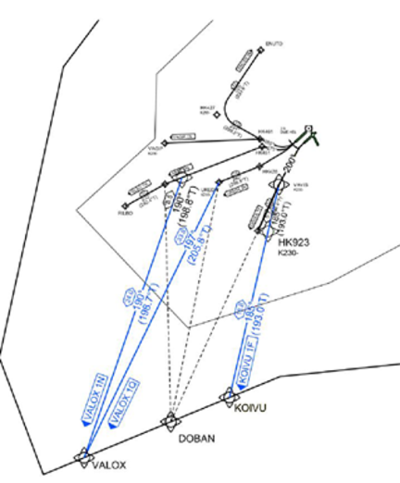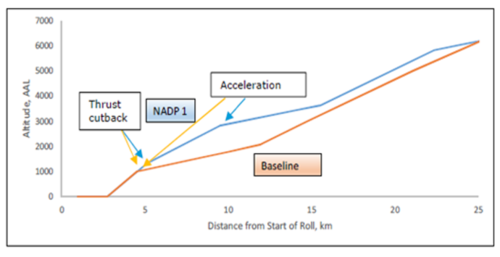1. The departure demand at Helsinki Airport increased during the last years and it was foreseen that the usage of the primary departure runway RWY-22R would reach its limits, especially during the afternoon peak hours between 16:00 h and 18:00 h;
2. An additional departure runway was required to handle the increased capacity of aircraft departures. The solution to increase the departure capacity was to use runway RWY-22L more intensively within already implemented noise restrictions;
3. Until April 2018, only one exit point (DOBAN) was used for the traffic to the south. Increased airplane traffic from RWY-22L that fulfilled the security requirements was enabled by splitting the DOBAN exit point into two separate exit points (KOIVU and VALOX) (Figure 3);

Figure 3: Splitting the DOBAN exit point into the two separate exit points VALOX and KOIVU
4. A change in the noise exposure was expected, so in order to prevent more annoyance, a new NADP1 procedure for all the Standard Instrumental Departures of the RWY-22L was studied. It implied that the aircraft climb higher with constant speed before acceleration is applied – aircraft are flying slower but at the higher altitude. The result is a lower noise level due to a higher flight altitude (Figure 4);

Figure 4: The NADP1 procedure enabled a reduction of the noise level due to higher flight altitude and longer noise attenuation distances
5. The estimated noise levels for departures using runway RWY-22L with standard procedures were compared with the estimated noise levels for the NADP1 departure procedures. Measurements proved that the application of the NADP1 departure procedure resulted in a reduction of the Lmax levels of approximately 3 dB. Summing up, the results for decision making were less noise exposure and emissions, less taxi time and air time;
6. The airspace was changed by replacing the exit point DOBAN with two new exit points KOIVU and VALOX. In the same context, the Standard Instrumental Departure (SID) route was adjusted to better avoid certain residential areas. This process was implemented with an active cooperation under the framework of Central Environmental Management group created in 2018;
7. Finally, while checking the success of the new procedures, noise measurements at the Runway RWY-22L confirmed the reduction of noise levels by applying NADP1 as compared to the commonly used departure procedure.